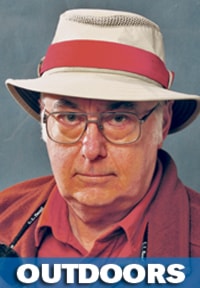It is strangely both comforting and disquieting finally to learn that one way of financing a drug habit, delusional dreams of terrorism, and shooting a soldier in the back in Ottawa is to work in Alberta’s oilpatch and save the big bucks by lodging at homeless shelters.
But I hope all that information is more credible than the RCMP assertion that the firearm Michael Zehaf-Bibeau used to kill Cpl. Nathan Cirillo, a Winchester Model 94, is “an old, uncommon gun.”
Old this particular specimen may be, but uncommon it is not. The Model 94 may be the most common firearm ever made; since 1894, more than seven million have been manufactured and they are still being made today. Even little old ladies in tennis shoes are likely to have a mint, never-fired “historic” 94 still in its box, carelessly stored where they live.
The “experts” are correct in saying the rifle is totally inadequate for an assault on Parliament Hill: it holds only eight rounds of low-power 30-30 ammunition, is slow to reload, one round at a time “up the tube,” and even in the hands of an expert at “fanning” lever actions, the rate of fire is very slow.
The 94 is a deer rifle, and more have probably been killed with it in North America than with many other deer rifles and calibres put together. Of the hundreds of modern deer hunters I know, only one, my friend and colleague, Neil Waugh, outdoors columnist for the Edmonton Sun, regularly uses a Model 94 30-30 to take his annual white tail sausage-chili buck.
So I just had to e-needle Neil about what the experts were saying about the deficiencies of his beloved and trusty firearm as an assault rifle.
North America’s finest big game trophy, the one that will never be surpassed, Boone & Crockett’s No. 1 ranked non-typical mule deer was taken near Chip Lake in 1926 by Ed Broder. I dote on mule deer and on the story, not the least because Broder was hunting with Philip Mohr, a relative of mine. Suffice here that Broder killed the magnificent buck at 200 yards with one shot from his Winchester 32 Special, which was a Model 94 chambered for the .32 Special cartridge created by Winchester in 1901, and which never really caught on, despite being slightly more powerful than the usual 30-30 round.
Coincidentally, in the early 1920s my father owned a Winchester 32 Special he had to use to survive, killing deer for winter food near Bull River, B.C., when the lumber mill shut down.
That experience soured him on big game hunting, and he soon sold the rifle.
Neil Waugh did not rise to my Model 94 “thutty thutty” bait, but did give a good account of himself and his Labrador, Penny, possibly the only wild pheasant hunters left in Alberta. I have been hearing and passing on glad tidings of good numbers of wild pheasants and sharp tail grouse but, unaccountably, since the season opened I have been told of fewer pheasant hunters out there than longtime observers can ever remember.
Neil and Penny had a good two and a half days, until Penny wore out, on a favourite portion of the thousands of acres of Eastern Irrigation District grazing and wild lands that are open for recreational use. They got wild pheasants the good old hard way, saw sharp tails and one monstrous mule deer, but only three rigs of hunters, two of which were road hunting.
Like anyone who knows the EID lands, Neil marvels: “It always amazes me that there are still places in Alberta like this or the Blackfoot Grazing Reserve where you can spend a whole day and not see a living soul except, maybe, for the odd Cenovus operator.”
Best luck was hunting along the creek, or drain, that flows east into the Red Deer River.
“The downside,” Neil says, “is shooting a bird that drops on the other side of the creek. Luck would have it my Bean boots held.”
Been there, done that, stripped down once or twice, even took to wearing hip waders when hunting creeks and drains alone.
Someday I’ll do a learned paper on why so many pheasant hunting dogs, including Labs, seem to have a problem with retrieving from the far side.
I’m suspecting the low hunter numbers are because the province is no longer planting hatchery birds for shooters who have forgotten wild birds, and where and how to hunt them.
There are even well-heeled hunters buying hatchery birds, planting them at former release sites, like Millicent, then summarily executing them before anyone else can.
“Now that ERSD is out of the release business and has no discernible pheasant policy,” Neil Waugh asks, “where does the pheasant licence fee go and what is it for?”
For absolutely nothing involving good management, just like all other fish and game licence fees in today’s Alberta.
Bob Scammell is an award-winning columnist who lives in Red Deer. He can be reached at bscam@telusplanet.net.
